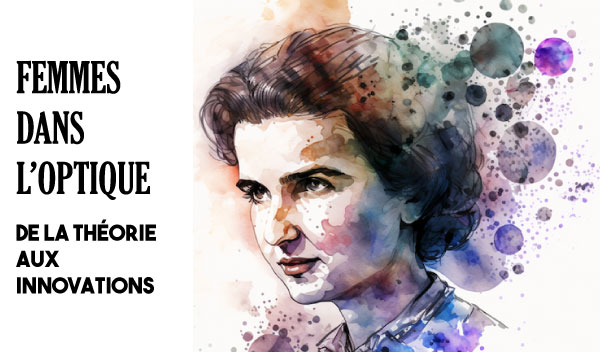FILE Women in optics: from theory to innovations

The history of optics is marked by decisive advances that have changed our perception of the world, from the infinitely small to the immensely large. While the names of men like Newton or Galileo often come up, female contributions are rarely highlighted. However, women, through their audacity and genius, have pushed back the boundaries of optical sciences. What were their roles in the scientific, industrial, and technological revolutions? How important is their legacy today? This is the subject of our dossier.
The discovery of optical laws: when women enrich the theory
The great optical theories that have revolutionized science owe much to women. Rosalind Franklin, famous for her contribution to the discovery of the structure of DNA, also left her mark on optical science. Her expertise in using X-rays to observe molecular structures laid the foundations for a more precise understanding of diffraction. This technique, which is based on the fundamental principles of optics , is now used in fields as diverse as biology, chemistry and physics. Franklin embodies a female scientist at the crossroads of disciplines, showing that optics goes far beyond the study of light.

In a more theoretical register, Émilie du Châtelet was able to bridge the gap between complex works and their accessibility. In particular, she translated into French and enriched Newton's Principia Mathematica , including sections on optics. Her pedagogical and critical approach allowed generations of scientists and engineers to better understand and apply the laws of refraction and reflection . In an era when women were often excluded from scientific circles, her contributions paved the way for others.
These figures illustrate how women have been able to contribute to optical theory despite social barriers. Rosalind Franklin and Émilie du Châtelet are not only historical examples; they remind us that optics, as a discipline, has always benefited from varied perspectives. Today, studies on women in science still show gaps, highlighting the importance of valuing these pioneers to inspire future generations.

Technical innovations: women at the forefront of the optical industry
The history of the optical industry would be incomplete without Katherine Burr Blodgett, the first female researcher at General Electric and the first female doctoral student in physics . In the 1930s, she developed anti-reflective glass using ultrathin molecular films , a revolutionary technique at the time. Her work, although based in physics, has found practical applications in eyeglasses, camera lenses, and even modern displays. Blodgett shows how one scientific innovation can transform an entire market, proving that optics is not just about vision but touches many aspects of our daily lives.

Maria Telkes, for her part, has explored optical applications in the field of solar energy . Her research on solar concentration systems demonstrates that optics can also address environmental challenges. By combining lens and mirror technologies with sustainable energy projects, she has paved the way for more environmentally friendly solutions.
In a more contemporary context, the rise of smart glasses illustrates the persistence of female innovations in optics. Companies like Luxexcel , which integrate 3D printed lenses into high-tech frames, owe their development to teams where diversity is encouraged. These examples show that women, although a minority in certain sectors, continue to excel in the application of optical sciences to real-world problems.
Scientific exploration: at the crossroads of optics and astronomy
Astronomy, a discipline that relies on optics, has seen the emergence of extraordinary women. Caroline Herschel, sister of William Herschel, was a pioneer in the observation of stars and comets. Using telescopes that were innovative for her time, she discovered several celestial objects, including the comet C/1786 P1, which now bears her name. Caroline Herschel was also the first woman to be paid for her scientific work , a rare recognition in her time.
Today, scientists like Sara Seager, an astrophysicist specializing in the search for exoplanets, use advanced optical instruments to analyze starlight. Her work, which relies on spectroscopy and gravitational lensing, demonstrates how optical tools have evolved since Herschel's time. These innovations make it possible to probe the universe with previously unimaginable precision.
These explorations illustrate how optics has always been at the heart of great astronomical discoveries . Female contributions, whether historical or contemporary, show that astronomy and optics remain fields where female innovation shines.

A social and cultural revolution: optics in the service of education and equality
Optical sciences have also been tools of emancipation for women. Hypatia of Alexandria, an ancient philosopher and scientist, taught optical principles at a time when women were rarely educated. By making this knowledge accessible, she set a precedent for scientific education.
In modern times, associative initiatives show how optics can improve the lives of millions of people, particularly women and children in isolated regions. These projects, often supported by women scientists, remind us that optics is not only a scientific discipline, but also a lever for transforming societies.
The democratization of optical technologies, from cheap glasses to advanced diagnostics, opens new perspectives for education and equal opportunities. The female figures who work in these fields embody a commitment to a science that serves all. We can also cite other female figures who are revolutionizing the sector in turn, such as Carole Riehl , founder of Optic for Good and resolutely committed to responsible optics and eyewear. But also Ansostyle , who through her originality and influence, has been able to offer a different and inspiring optic.
The history of optical sciences reveals a rich and diverse heritage, in which women have played a central role. From the discovery of physical laws to industrial innovation, including astronomical explorations, they have helped shape our understanding of the world. While recognition of these contributions remains uneven, their impact is undeniable . By rediscovering these pioneers, we honor their legacy and draw inspiration from their audacity to build a more inclusive scientific future.


